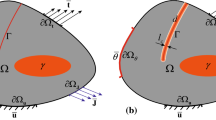Abstract
A modification of Sommer's classical experiment [4] has been used to fracture rods of a brittle epoxy resin in mixed mode I/III stress conditions. The nucleation and growth of cracks in an increasing K III/K I stress field have been investigated, particularly in relation to the formation of river lines and the evolution of multiple cracks between river lines to form smooth helicoid surfaces. The fractographic features associated with the progressive development of river line patterns involving crack bowing at river line steps, interaction between arrays of cracks and the coalescence of river lines are described. As K III/K I increases the scale of the river line patterns increases but the patterns remain self similar. Using principles from differential geometry it is shown that helicoid surfaces can be generated entirely by crack evolution involving ‘tilting’ without ‘twiting’.
Similar content being viewed by others
References
D.Hull, International Journal of Fracture 62 (1993) 119–138.
C.DeFreminville, Revue de Metallurgie 11 (1914) 971–1056.
F.W.Preston, Journal of the American Ceramic Society 14 (1931) 419–427.
E.Sommer, Engineering Fracture Mechanics 1 (1969) 539–546.
A.Smekal, Osterreichische Ingenieur Arch. 7 (1953) 49–70.
H.Neuber, Kerbspannungslere 2, Springer, Berlin (1958).
Y.Murakami and S.Aoki (eds), Stress Intensity Factors Handbook, Pergamon, Oxford (1987).
J.P.Bentham and W.T.Koiter, in Mechanics of Fracture 1, Methods of Analysis and Solutions of Crack Problems, G.C.Sih (ed.), Noordhoff International Publishing, Leyden (1973) 131–178.
G.C.Sih, Experimental Evaluation of Stress Concentration and Stress Internsity Factors, Martinus Nijhoff Publishers, Amsterdam (1981).
D.Hull, International Journal of Fracture 66 (1994) 295–312.
G. Henry and J. Plateau, La Microfractographie, institute de Recherches de la Siderurgie Francais (IRSID): Editions Metaux (1967).
J.Friedel, Dislocations, Pergamon Press, Oxford (1964).
F.F.Lange and K.A.D.Lambe, Philosophical Magazine 18 (1968) 129–136.
J.J.Gilman, Transactions AIME 203 (1955) 1252.
J.R.Low, in Fracture, B.L.Averbach, D.K.Felbeck, G.T.Hahn, D.A.Thomas (eds), John Wiley and Sons, Inc, New York (1959) 68–90.
Author information
Authors and Affiliations
Additional information
Emeritus Goldsmiths' Professor of Metallurgy, University of Cambridge, U.K.
Rights and permissions
About this article
Cite this article
Hull, D. The effect of mixed mode I/III on crack evolution in brittle solids. Int J Fract 70, 59–79 (1994). https://doi.org/10.1007/BF00018136
Received:
Accepted:
Issue Date:
DOI: https://doi.org/10.1007/BF00018136




